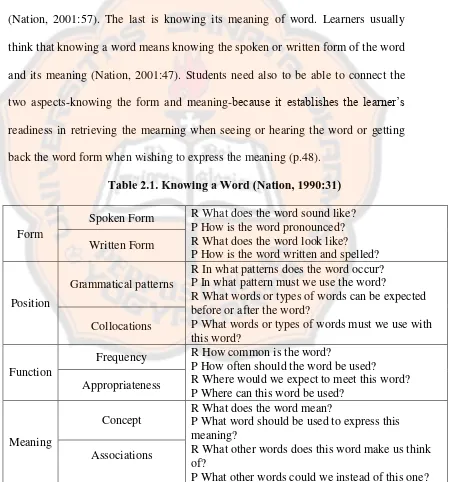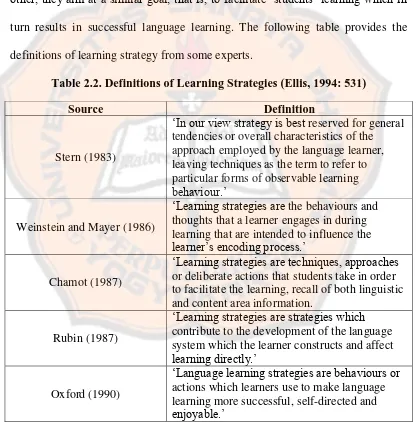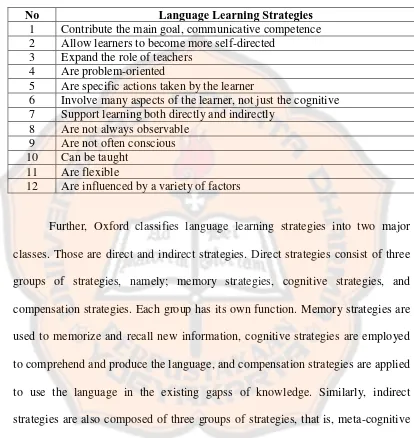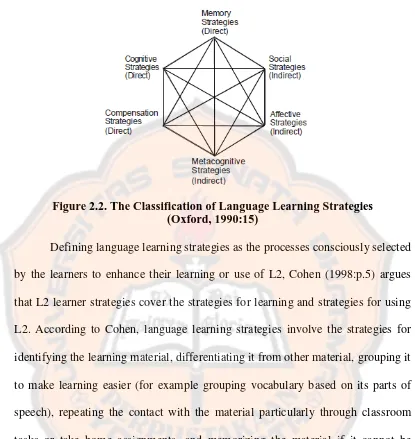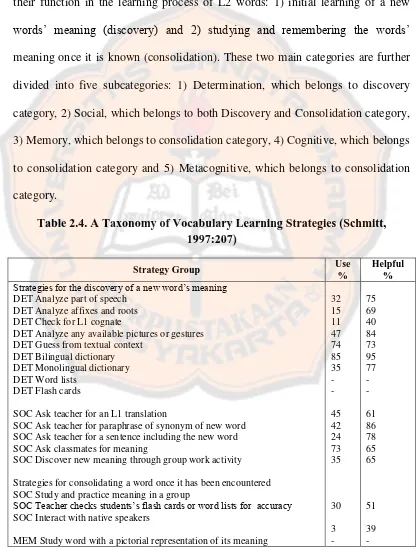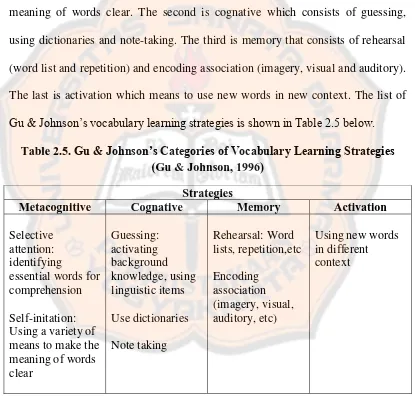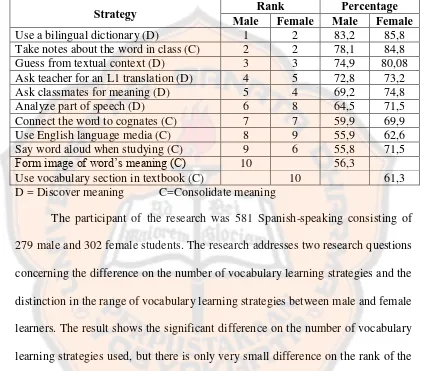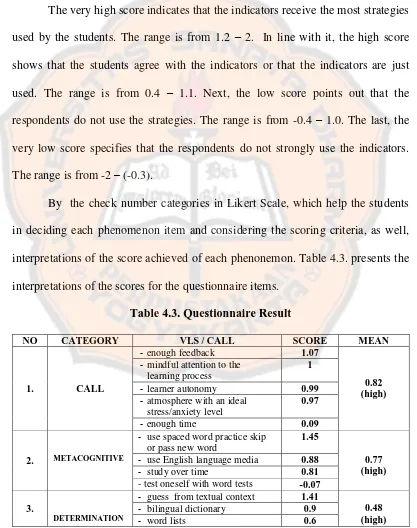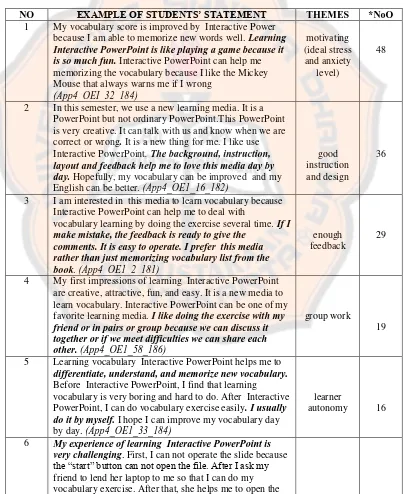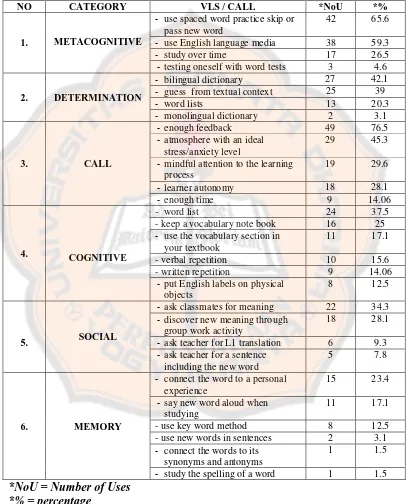ABSTRACT
Hanardi, Levyn Gracia. 2015. Students’ Vocabulary Learning Strategies Adopted in Interactive PowerPoint Application for Language Learning (IPALL).
Yogyakarta: Graduate Program on English Language Studies, Sanata Dharma University.
Vocabulary Learning Strategies (VLS) have meaningful contribution to
students’ language learning. It is in line with the effort for helping memorize and recall second language words. To support the vocabulary learning process, students need to use a medium to motivate them and enrich their vocabulary simultaneously. Interactive PowerPoint Application for Language Learning (IPALL) is one of the engaging media that is used in learning vocabulary. IPALL is a set of PowerPoint templates which are developed for teachers as media to write objective tests or exercises for their students. This research is aimed at discovering information about students’ vocabulary learning strategies using IPALL. There are three research questions in this study: (1) Which Vocabulary Learning Strategies (VLS) do the students use in learning vocabulary adopted in Interactive PowerPoint Application for Language Learning (IPALL)?, (2) Why do the students use those strategies?, and (3) How effective is the learning of vocabulary adopted in Interactive PowerPoint Application for Language Learning (IPALL) ?
This study employed a mixed-method design as the analysis used both qualitative and quantitative data. A survey research was done in gathering the data. This study used questionnaire to gain the VLS in learning vocabulary using IPALL. The interview was conducted in order to dig out more about students’ vocabulary learning strategies using IPALL. The target population of this study was the class X students in SMK N 7 Yogyakarta in academic year 2014/2015. The samples of this study were 64 out of 224 students of the whole population. A further analysis about the quasi-experimental analysis gave another finding of this study. The use of triangulation was strengthened by using students’ score in order
to support the result about students’ vocabulary learning strategies using IPALL. The students’ before, after and gain scores were used to know the effectiveness of
learning vocabulary using IPALL.
The third research question is answered based on the quasi experimental analysis. The result about the effectiveness of IPALL to learn vocabulary is evidenced from Wilcoxon and U-Mann Whitney Test. Based on Wilcoxon test, the result shows the 2-tailed significance (P-value) of .000 means that P is off the scale (Z Wilcoxon is at -6.374 at P=0.05). It shows that P < 0.05 means that the result is significant. Based on U-Mann Whitney test, the result shows that the 2-tailed significance (P-value) of .000. The result before using IPALL to learn vocabulary is 0.14 while after using IPALL to learn vocabulary is 0.00. Therefore, the gain score is 0.00. It shows that all the results are P < 0.05. It means that the result is significant.
This research is beneficial for teachers and researchers. This research is
aimed to give insight about how students’ Vocabulary Learning Strategies (VLS)
ABSTRAK
Hanardi, Levyn Gracia. 2015. Students’ Vocabulary Learning Strategies Adopted in Interactive PowerPoint Application for Language Learning (IPALL).
Yogyakarta: Program Pasca Sarjana Kajian Bahasa Inggris, Universitas Sanata Dharma.
Vocabulary Learning Strategies (VLS) memiliki kontribusi yang berarti bagi siswa karena hal itu sejalan dengan upaya menghafalkan dan mengingat kembali kosakata yang terdapat dalam bahasa kedua. Untuk mendukung proses pembelajaran kosakata, siswa perlu menggunakan media yang dapat memotivasi sekaligus memperkaya kosakata mereka. Interactive PowerPoint Application for
Language Learning (IPALL) adalah salah satu media yang menarik untuk digunakan dalam belajar kosakata. IPALL adalah seperangkat template-template PowerPoint yang dikembangkan bagi guru untuk membuat latihan-latihan bagi siswanya. Penelitian ini bertujuan untuk menemukan informasi tentang VLS
dengan menggunakan IPALL. Ada tiga rumusan masalah dalam penelitian ini: (1) VLS apakah yang digunakan siswa dalam belajar kosakata menggunakan Interactive PowerPoint Application for Language Learning (IPALL)?, (2) Mengapa siswa menggunakan strategi-strategi itu?, (3) Seberapa efektifkah mengajar kosakata dengan menggunakan IPALL?
Penelitian ini menggunakan metodologi mixed-method karena menggunakan data kualitatif dan kuantitatif. Survey dilakukan untuk mengumpulkan data. Penelitian ini menggunakan kuesioner to mendapatkan data
VLS dalam belajar kosakata dengan IPALL. Wawancara dilaksanakan untuk menggali lagi tentang VLS dengan IPALL. Populasi penelitian ini adalah siswa kelas X SMK N 7 Yogyakarta tahun ajaran 2014/2015. Sample penelitian ini adalah 64 siswa dari 224 jumlah keseluruhan siswa. Analisa lain dari analisa quasi-eksperimen memberikan temuan lain mengenai penelitian ini. Penggunaan trianggulasi yang diperkuat dari data nilai siswa mendukung hasil VLS dengan
IPALL. Nilai sebelum, sesudah dan peningkatan nilai siswa digunakan untuk mengetahui keefektifan belajar kosakata dengan menggunakan IPALL.
Rumusan masalah pertama dan kedua telah dijawab menggunakan analisis data kuesioner dan wawancara. Hasil penelitian ini menunjukkan bahwa strategi yang paling banyak digunakan siswa adalah metacognitive strategies. Strategi ini digunakan karena fitur IPALL telah memenuhi prinsip dari CALL. Strategi kedua adalah determination strategies karena siswa masih belajar kosakata dengan frekuensi kata yang rendah. Strategi ketiga adalah cognitive strategies karena siswa menggunakan interaksi intrapersonal antara komputer dan dirinya. Strategi keempat adalah social strategies karena IPALL dapat digunakan untuk pembelajaran di dalam dan di luar kelas. Siswa juga dapat menerapkan interaksi interpersonal dalam proses pembelajaran bersama teman dan gurunya. Setelah itu, strategi yang paling jarang digunakan adalah memory strategies. Hal ini dikarenakan siswa harus belajar kosakata dengan frekuensi kata yang tinggi.
Wilcoxon, hasil menunjukkan bahwa 2-tailed significance (nilai P) dari .000 berarti (Z Wilcoxon di -6.374 dimana P=0.05). Ini membuktikan bahwa P < 0.05 yang berarti hasilnya signifikan. Berdasarkan uji U-Mann Whitney, hasil menunjukkan bahwa 2-tailed significance (nilai P) dari .000. Hasil sebelum menggunakan IPALL untuk belajar vocabulary adalah 0.14 sedangkan setelah menggunakan IPALL adalah 0.00. Oleh karena itu, semua hasil menunjukkan bahwa P < 0.05. Hasil yang diperoleh adalah signifikan.
Penelitian ini bermanfaat bagi para guru dan peneliti lain. Penelitian ini bertujuan untuk memberikan wawasan mengenai bagaimana VLS diterapkan oleh siswa saat belajar kosakata menggunakan IPALL. Penelitian ini dapat memberikan informasi dan deskripsi yang signifikan mengenai penggunaan IPALL untuk belajar
STUDENTS’ VOCABULARY LEARNING STRATEGIES ADOPTED IN INTERACTIVE POWERPOINT APPLICATION FOR LANGUAGE
LEARNING (IPALL)
A THESIS
Presented as Partial Fulfillment of the Requirements for the Degree of Magister Humaniora (M.Hum)
in English Language Studies
by
Levyn Gracia Hanardi Student Number: 136332004
THE GRADUATE PROGRAM IN ENGLISH LANGUAGE STUDIES SANATA DHARMA UNIVERSITY
i
STUDENTS’ VOCABULARY LEARNING STRATEGIES ADOPTED IN INTERACTIVE POWERPOINT APPLICATION FOR LANGUAGE
LEARNING (IPALL)
A THESIS
Presented as Partial Fulfillment of the Requirements for the Degree of Magister Humaniora (M.Hum)
in English Language Studies
by
Levyn Gracia Hanardi Student Number: 136332004
THE GRADUATE PROGRAM IN ENGLISH LANGUAGE STUDIES SANATA DHARMA UNIVERSITY
iv
Psalms 1 : 1-3
1.
How blessed is the one who does not follow the advice
of the wicked, or stand in the pathway with sinners, or
sit in the assembly of scoffers!
2.
Instead he finds pleasure in obeying the Lord’s
commands; he meditates on his commands day and
night.
3.
He is like a tree planted by flowing streams; it yields
its fruit at the proper time, and its leaves never fall off.
He succeeds in everything he attempts.
I dedicate my thesis to:
Jesus Christ, My Almighty God
vii
ACKNOWLEDGEMENTS
First and foremost, I would like to express my deepest gratitude to Jesus Christ, my Savior and my Lord. He always gives me strength, blessing and guidance during the process of writing my thesis. I am truly blessed by Him so that I could struggle to do my best efforts in finishing this thesis. Without Him, I will not be able to finish my thesis successfully.
I would like to express my sincere thanks to my thesis advisor, Dr. B.B. Dwijatmoko, M.A., who gives his valuable guidance, advice, patience, and times from the beginning until the accomplishment of this thesis. My gratitude also goes to Dr. J. Bismoko, F.X. Mukarto, Ph.D., Dra Novita Dewi, M.S., M.A. (Hons)., Ph.D., and all KBI lecturers for sharing their knowledge, giving wonderful lessons and teaching me a lot of things. My special thank goes to Paulus Kuswandono, M.Ed., Ph.D. for the suggestions that improve my writing. I also thank Mbak Lely and Pak Mul for their assistance during my study.
Next, I am deeply grateful to the headmaster of SMK N 7 Yogyakarta, Ibu Dra. Titik Komah Nurastuti, the English teachers, Bp. Yohanes Budi Susilo, S.Pd. and Ibu Nining Widuri, S.Pd. who always give their time for me to conduct my research. I thank them for permitting me to conduct my research in the school.
viii
high spirit and strength to do my best in finishing my thesis. I also thank to my beloved fiance, Kristiyan Adi Nugroho who never stops loving me. I thank him for his care when I am really down. He is so meaningful for me.
Special thanks go to my friends, KBI A 2013 : Mbak Yunita, Mbak Aik, Ce Vivi, Joan, Bundo Wulan, Dita,Mbak Dian, Mbak Anin, Siwi, Mas Desta, Mbak Nurul, Mommy Sitta, Dewi, Mas Bay, Mbak Adria, Mbak Dina, Mbak Gaby, Sir Ryan, GRP 2014: Mbak Mimi, Mbak Desy, Ika, Mbak Tanti, Mbak Belinda, Mbak Anna, Mbak Ratri, Mbak Dewinta, Mas Vendi, Putri and all KBI friends for their willingness to share their knowledge and happiness.
Last but not least, I thank for those who have supported and encouraged me to finish my thesis. God always be with us.
ix
STATEMENT OF ORIGINALITY... v
LEMBAR PERNYATAAN PERSETUJUAN PUBLIKASI... vi
ACKNOWLEDGEMENTS... vii
CHAPTER II. LITERATURE REVIEW... 13
A.Review of Related Literature... 13
1. The Nature of Vocabulary... 13
a. Definition of a Word... 14
b. Knowing a Word... 15
c. Categories of Word Knowledge... 16
d. Breadth and Depth Vocabulary... 18
e. Receptive and Productive of Vocabulary Knowledge... 18
2.Vocabulary Learning... 20
a. Principles of Vocabulary Learning... 20
b. Goals of Vocabulary Learning... 21
c. Intentional v.s. Incidental Vocabulary Learning... 22
d. Low Frequency Words... 24
1) Word Guessing from Context... 24
2) Deliberate Learning with Word Cards... 25
3) Memorization with Word Parts... 25
4) Dictionary Use... 26
e. High Frequency Words... 26
1) Meaning-focused Input... 27
2) Meaning-focused Output... 27
3) Language-focused Learning... 28
x
5.Computer-Assissted Language Learning... 42
6. Interactive PowerPoint Application for Language Learning (IPALL)... 46
F. Trustwortiness of the Study... 87
CHAPTER IV. RESULTS AND DISCUSSIONS... 90
A.Research Results ... 90
1. Result from Students’ Vocabulary Learning Strategies... 91
2. Result from Students’ Open-Ended Questionnaire... 93
3. Result from Students’ Interview... 97
4. Result from Students’ Scores... 100
5. Result from Quasi-Experimental Analysis... 104
B.Discussion... 106
1. Metacognitive Strategies... 106
a. Skip or Pass New Word... 106
b. Use English Language Media... 108
c. Study Over Time...110
d. Test Oneself with Word Tests... 119
2. Determination Strategies... 121
a. Guess from Textual Context ... 122
b. Use Bilingual Dictionary... 124
xi
d. Use Monolingual Dictionary... 128
3. Cognitive Strategies... 130
a. Verbal Repetition... 130
b. Keep a Vocabulary Notebook... 132
c. Put English Labels on Physical Objects ... 133
d. Use Vocabulary Section in Textbook... 133
e. Written Repetition... 135
4. Social Strategies... 135
a. Ask Classmates for Meaning... 136
b. Discover New Meaning through Group Work Activity... 137
c. Ask Teacher for L1 Translation... 139
d. Ask Teacher for A Sentence Including the New Word... 141
5. Memory Strategies...142
a. Connect the Word to Its Synonyms and Antonyms...142
b. Use Key Word Method... 144
c. Connect the Word to A Personal Experience... 145
d. Say the New Word Aloud When Studying... 147
e. Study the Spelling of A Word... 149
f. Use New Words in Sentences... 149
C.Supportive Data from Quasi Experimental Result... 150
CHAPTER V. CONCLUSIONS AND SUGGESTIONS... 158
A.Conclusions... 158
1. Students Vocabulary Learning Strategies Adopted in IPALL... 158
2. The Effectiveness of Teaching Vocabulary Adopted in IPALL... 161
B.Suggestions... 162
1. For Students...163
2. For English Teachers...164
3. For Future Researchers...165
BIBLIOGRAPHY ... 166
xii
LIST OF TABLES
Table Page
2.1. Knowing a Word (Nation, 1990:31)... 17
2.2. Definitions of Learning Strategies (Ellis, 1994: 531)... 30
2.3. Features of Language Learning Strategies (Oxford, 1990:9)... 31
2.4. A Taxonomy of Vocabulary Learning Strategies (Schmitt, 1997: 207)... 36
2.5. Gu & Johnson’s Categories of Vocabulary Learning Strategies (Gu & Johnson, 1996)... 39
2.6. The Ten Most Frequently Used Vocabulary Strategies (Catalan, 2003:62)... 40
2.7. The Ten Least Frequently Used Vocabulary Strategies (Catalan, 2003: 62)... 41
2.8. A Taxonomy of Kinds of Vocabulary Learning Strategies (Nation, 2001:218)... 42
3.1. Research Timeline... 74
3.2. The Blueprint of the Questionnaire... 79
3.3. The Blueprint of the Interview... 81
3.4. The Mean Criteria (Sudijono, 2009: 175)... 83
3.5. Coding System for Open-Ended Questionnaire... 83
3.6 Coding for Participant Number of Interview... 84
3.7 Coding System for Interview... 85
4.1. The Check Number and The Converted Score... 91
4.2. The Mean Criteria (Sudijono, 2009: 175) ... 92
4.3. Questionnaire Result... 92
4.4. List of Emerging Students’ Experience and Progress of Learning Vocabulary Adopted in IPALL (Open-Ended Questions) 94 4.5. List of Students’ Vocabulary Learning Strategies Adopted in IPALL (Open-Ended Questions)... 96
4.6. Interview Result... 98
4.7. Total Score (Before, After, and Gain)... 101
4.8. Descriptive Statistics of Vocabulary Learning Strategies... 101
4.9. Descriptive Statistics of Experiment and Control Group... 102
4.10. One-Sample Kolmogorov-Smirnov Test (Experiment Group)... 104
4. 11.Test of Homogeneity of Variances... 105
4. 12.The Result of Wilcoxon Test (Experiment Group)... 151
4.12.1. Descriptive Statistics of Experiment Group... 151
4.12.2. Ranks of Experiment Group... 153
4.12.3. Wilcoxon Signed Ranks Test of Experiment Group... 153
4. 13.The Result of Wilcoxon Test (Control Group)... 154
4.13.1. Descriptive Statistics of Control Group... 154
4.13.2. Ranks of Control Group... 154
4.13.3. Wilcoxon Signed Ranks Test of Control Group... 155
xiii
LIST OF FIGURES
Figure Page
2.1. Intentional versus Incidental Learning... 23
2.2. Learning Strategy... 32
2.3. IPALL for Vocabulary Builder (Matching 1)... 54
2.4. IPALL for Vocabulary Builder (Matching 2)... 54
2.5. IPALL for Vocabulary Builder (Matching 3)... 55
2.6. IPALL for Multiple Choice 1... 57
2.7. IPALL for Multiple Choice 2... 57
2.8. IPALL for Multiple Choice 3... 57
3.1. The Steps in Conducting Survey Research (Creswell, 2013: 403-404)... 71
3.2. Posttest-Only Design of Quasi Experimental Research (Creswell,2012)... 73
3.3 Ideal Mean and Ideal Standard Deviation (Munadi, 2014)... 82
3.4. The Mean Criteria Formulation (Sudijono, 2009: 175)... 82
3.5 The Wilcoxon Signed-Rank Test Formula (Siegel, 1997:99)... 86
3.6 The U-Mann Whitney Test Formula (Siegel, 1997:150)... 86
3.7. The Z Formulation of U-Mann Whitney Test Formula Siegel, 1997:154)... 87
4.1 The Total Mean of Experiment Group... 102
4.2. The Total Mean of Experiment and Control Group... 103
4.3 ‘Previous’ and ‘Next’ Button in a Slide of IPALL... 107
4.4. The Feeback if the Answer is Wrong (IPALL Multiple Choice)... 113
4.5. The Feeback if the Answer is Correct (IPALL Multiple Choice)... 113
4.6. The Feeback if the Answer is Wrong (IPALL Matching)... 114
4.7. The Feeback if the Answer is Correct (IPALL Matching)... 114
4.8. The Context in Multiple Choice Exercise... 123
4.9. Matching Exercise (English-Bahasa Indonesia)... 125
4.10 New Word List... 127
4.11. The Matching Exercise (English-English)... 129
4.12. Vocabulary Section in Textbook... 134
4.13. The ‘Confirm’ Button... 140
4.14. Parts of Speech in MatchingExercise... 143
4.15. Keyword Method in IPALL... 144
xiv
LIST OF ABBREVIATIONS
CALL : Computer-Assissted Language Learning
IPALL : Interactive PowerPoint Application for Language Learning VLS : Vocabulary Learning Strategies
X AK 1 : X Akuntansi 1
X AK 2 : X Akuntansi 2
X MM : X Multi Media
xv
LIST OF APPENDICES
Appendix Page
Appendix 1. The Permission Letter... 172
Appendix 2. The Questionnaire... 173
Appendix 3. The Questionnaire Result... 177
Appendix 4. Data from Open-ended Questionnaire... 180
Appendix 5. Students’Score (X MM)... 190
Appendix 6. Students’Score (X AK1)... 191
Appendix 7. Students’Score (X UPW)... 192
Appendix 8. Students’Score (X AK 2)... 193
Appendix 9. Interview Guidelines... 194
Appendix 10. Interview Result... 198
xvi ABSTRACT
Hanardi, Levyn Gracia. 2015. Students’ Vocabulary Learning Strategies Adopted in Interactive PowerPoint Application for Language Learning (IPALL).
Yogyakarta: Graduate Program on English Language Studies, Sanata Dharma University.
Vocabulary Learning Strategies (VLS) have meaningful contribution to students’ language learning. It is in line with the effort for helping memorize and recall second language words. To support the vocabulary learning process, students need to use a medium to motivate them and enrich their vocabulary simultaneously. Interactive PowerPoint Application for Language Learning (IPALL) is one of the engaging media that is used in learning vocabulary. IPALL is a set of PowerPoint templates which are developed for teachers as media to write objective tests or exercises for their students. This research is aimed at discovering information about students’ vocabulary learning strategies using IPALL. There are three research questions in this study: (1) Which Vocabulary Learning Strategies (VLS) do the students use in learning vocabulary adopted in Interactive PowerPoint Application for Language Learning (IPALL)?, (2) Why do the students use those strategies?, and (3) How effective is the learning of vocabulary adopted in Interactive PowerPoint Application for Language Learning (IPALL) ?
This study employed a mixed-method design as the analysis used both qualitative and quantitative data. A survey research was done in gathering the data. This study used questionnaire to gain the VLS in learning vocabulary using IPALL. The interview was conducted in order to dig out more about students’ vocabulary learning strategies using IPALL. The target population of this study was the class X students in SMK N 7 Yogyakarta in academic year 2014/2015. The samples of this study were 64 out of 224 students of the whole population. A further analysis about the quasi-experimental analysis gave another finding of this study. The use of triangulation was strengthened by using students’ score in order to support the result about students’ vocabulary learning strategies using IPALL. The students’ before, after and gain scores were used to know the effectiveness of learning vocabulary using IPALL.
xvii
strategies used by students are memory strategies. Memory strategies are the least strategies because they demand high frequency of words.
The third research question is answered based on the quasi experimental analysis. The result about the effectiveness of IPALL to learn vocabulary is evidenced from Wilcoxon and U-Mann Whitney Test. Based on Wilcoxon test, the result shows the 2-tailed significance (P-value) of .000 means that P is off the scale (Z Wilcoxon is at -6.374 at P=0.05). It shows that P < 0.05 means that the result is significant. Based on U-Mann Whitney test, the result shows that the 2-tailed significance (P-value) of .000. The result before using IPALL to learn vocabulary is 0.14 while after using IPALL to learn vocabulary is 0.00. Therefore, the gain score is 0.00. It shows that all the results are P < 0.05. It means that the result is significant.
xviii ABSTRAK
Hanardi, Levyn Gracia. 2015. Students’ Vocabulary Learning Strategies Adopted in Interactive PowerPoint Application for Language Learning (IPALL).
Yogyakarta: Program Pasca Sarjana Kajian Bahasa Inggris, Universitas Sanata Dharma.
Vocabulary Learning Strategies (VLS) memiliki kontribusi yang berarti bagi siswa karena hal itu sejalan dengan upaya menghafalkan dan mengingat kembali kosakata yang terdapat dalam bahasa kedua. Untuk mendukung proses pembelajaran kosakata, siswa perlu menggunakan media yang dapat memotivasi sekaligus memperkaya kosakata mereka. Interactive PowerPoint Application for
Language Learning (IPALL) adalah salah satu media yang menarik untuk digunakan dalam belajar kosakata. IPALL adalah seperangkat template-template PowerPoint yang dikembangkan bagi guru untuk membuat latihan-latihan bagi siswanya. Penelitian ini bertujuan untuk menemukan informasi tentang VLS
dengan menggunakan IPALL. Ada tiga rumusan masalah dalam penelitian ini: (1) VLS apakah yang digunakan siswa dalam belajar kosakata menggunakan Interactive PowerPoint Application for Language Learning (IPALL)?, (2) Mengapa siswa menggunakan strategi-strategi itu?, (3) Seberapa efektifkah mengajar kosakata dengan menggunakan IPALL?
Penelitian ini menggunakan metodologi mixed-method karena menggunakan data kualitatif dan kuantitatif. Survey dilakukan untuk mengumpulkan data. Penelitian ini menggunakan kuesioner to mendapatkan data
VLS dalam belajar kosakata dengan IPALL. Wawancara dilaksanakan untuk menggali lagi tentang VLS dengan IPALL. Populasi penelitian ini adalah siswa kelas X SMK N 7 Yogyakarta tahun ajaran 2014/2015. Sample penelitian ini adalah 64 siswa dari 224 jumlah keseluruhan siswa. Analisa lain dari analisa quasi-eksperimen memberikan temuan lain mengenai penelitian ini. Penggunaan trianggulasi yang diperkuat dari data nilai siswa mendukung hasil VLS dengan
IPALL. Nilai sebelum, sesudah dan peningkatan nilai siswa digunakan untuk mengetahui keefektifan belajar kosakata dengan menggunakan IPALL.
Rumusan masalah pertama dan kedua telah dijawab menggunakan analisis data kuesioner dan wawancara. Hasil penelitian ini menunjukkan bahwa strategi yang paling banyak digunakan siswa adalah metacognitive strategies. Strategi ini digunakan karena fitur IPALL telah memenuhi prinsip dari CALL. Strategi kedua adalah determination strategies karena siswa masih belajar kosakata dengan frekuensi kata yang rendah. Strategi ketiga adalah cognitive strategies karena siswa menggunakan interaksi intrapersonal antara komputer dan dirinya. Strategi keempat adalah social strategies karena IPALL dapat digunakan untuk pembelajaran di dalam dan di luar kelas. Siswa juga dapat menerapkan interaksi interpersonal dalam proses pembelajaran bersama teman dan gurunya. Setelah itu, strategi yang paling jarang digunakan adalah memory strategies. Hal ini dikarenakan siswa harus belajar kosakata dengan frekuensi kata yang tinggi.
xix
Wilcoxon, hasil menunjukkan bahwa 2-tailed significance (nilai P) dari .000 berarti (Z Wilcoxon di -6.374 dimana P=0.05). Ini membuktikan bahwa P < 0.05 yang berarti hasilnya signifikan. Berdasarkan uji U-Mann Whitney, hasil menunjukkan bahwa 2-tailed significance (nilai P) dari .000. Hasil sebelum menggunakan IPALL untuk belajar vocabulary adalah 0.14 sedangkan setelah menggunakan IPALL adalah 0.00. Oleh karena itu, semua hasil menunjukkan bahwa P < 0.05. Hasil yang diperoleh adalah signifikan.
1
CHAPTER I
INTRODUCTION
As an introductory chapter, this part will discover the problem statement that is important to build framework for the study. This chapter covers the research background, problem identification, problem limitation, research questions, research objectives, and research benefits.
A. RESEARCH BACKGROUND
Education curriculum in Indonesia has been changed several times. The curriculum 2013 is the newest curriculum of national education of Indonesia. The new curriculum is implemented to elementary school, junior high school, senior high school and also vocational high school. Some schools that are chosen by the government have to implement the curriculum 2013. However, a lot of pros and contras happen in the middle of the implementation of this new curriculum. It makes the new Minister of Education changes the curriculum into the previous curriculum, that is, the 2006 school-level autonomy curriculum. Basically, the implementation of every curriculum in Indonesia demands students to be more active in learning. Moreover, they have to learn all subjects independently. Therefore, teachers have to facilitate better learning activities that can help their students to fulfill the goal of the curriculum.
independent learners during the process of second language learning. Therefore, teachers have to help the students to find the best strategy in learning vocabulary. It has been suggested that teaching vocabulary should not only consist of teaching specific words but also aims at equipping learners with strategies necessary to expand their vocabulary knowledge (Hulstjin, 1993, cited in Ghazal, 2012). According to Schmitt & McCarthy (1997), at the entrance of twenty first century, vocabulary acquisition has held a more important role at the that is, the role in second language learning. It is viewed that the teacher is encountered with the challenge of how best to assisst students memorize and get back second language words. In relation with the effort for helping the students memorize and recall second language words, the use of learning strategy have meaningful contribution to students’ learning.
Vocabulary takes an important role in all language skills (listening, speaking, reading and writing). Alhaysony (2012) states that the acquisition of vocabulary is just as important as the acquisition of grammar, both of which act as essential components of all language uses. According to Harmer (1990) vocabulary is needed for expressing meaning and in using the receptive skills (listening and reading) and the productive skills (speaking and writing). Harmer says “if language structures make up the skeleton of language, then it is vocabulary that provides the vital organs and the flesh (p.8).”
students use appropriate learning strategies, the learning process will lead to better achievement. According to O’ Malley & Chamot (1990:1), learning strategies are
viewed as the special thoughts or behaviors that individuals use to help them comprehend, learn, or retain new information. Therefore, learning strategies are used to process new information in learner’s mind. Language learning strategies
enable the learners to manage their own learning. Oxford (1990) claims that learning strategies are very important particularly for language learning, in that they are tools for the learner’s active and self-directed movement, which is
essential to develop communicative competence. This indicates that language learning strategies play an important aspects that must be considered to get the success of language learning process (p.1). Language learning strategies are tools for language learning which make learning easier, faster, more enjoyable, more self-directed, more effective and more transferable to new situations (p.8).
Vocabulary Learning Strategies (VLS) are one part of language learning strategies which in turn are part of general learning strategies (Nation, 2001). Second language (L2) acquisition emphasizes on the development of strong vocabulary. VLS are a part of language learning strategies which lead our understanding of the processes learners use to develop their skills in a second language. According to Nation (2001) in VLS, a strategy is needed to a) involve choice, that is, there are several strategies to choose from; b) be complex, that is, there are several steps to learn; c) require knowledge and benefit from training; and d) increase the efficiency of vocabulary learning and vocabulary use.
states by using computer in learning a language, key principles of vocabulary instruction can be fostered. Nowadays, technology is inseparable with teaching and learning activities. The presence of technology in language classroom is a prerequisite for interesting language instruction in language learning. Technology can be used to enhance teaching and learning activity. Technology is now common be used in most high schools and universities (McKeachie & Svinicki, 2006, p.235). The application of technology is needed for preparing the students to face challenge of their future. Thus, besides teaching the language, teachers also give opportunities for the students to get familiar and with technology. Accordingly, most of the students and the teachers use technology almost everyday. Reeves (1998) states that there are two major approaches in using technology and media, which are learning from technology and media, and learning with technology and media.
One example of technology is PowerPoint. PowerPoint has been used since 1990s. PowerPoint is firstly introduced in the business world. The number of PowerPoint copies in circulation are estimated to be 400 milion copies in 2002 (Craig & Armenic, 2004). Parker (2001, p.2) states that “to appear at a meeting without PowerPoint would be unwelcome and vaguely pretentious, like wearing no shoes.” Further, the use of PowerPoint has widespread. It is already common to
text, picture, audio and even video. Therefore, teaching and learning will become more interesting.
Actually, in this research, the researcher sees the benefit of Interactive PowerPoint Application for Language Learning (IPALL) which has been used in a vocational high school as one of learning media. IPALL is one of the media that is used in language learning activities. IPALL is a set of PowerPoint templates which are developed for teachers as media to write objective tests or exercises for their students. The objective tests or exercises consist of five kinds: multiple choice, completion, matching, cloze-test and true false (Dwijatmoko, 2015, in print).
This research focuses on the strategy for learning vocabulary adopted in Interactive PowerPoint Application for Language Learning (IPALL). According to Catalan (2003), the main goal of vocabulary learning strategy is to discover how words are learned and what part is played by different processes such as; lexical inferencing, guessing the meaning of words from context, memory processes, lexical simplification, and finally lexical transfer from L1 to L2. A large number of researchers have conducted research to find out the best way in helping the students to learn vocabulary. Most of them have also made some helpful techniques and media to support students’ learning. Some of them use
survey research to describe the use of those techniques and media.
IPALL. Different from the previous research, in this research, the researcher relates the use of IPALL in learning vocabulary. Actually, this study is also under one umbrella with another study conducted by Sastrikirana (2015). She is also writing her study about the use of IPALL in vocabulary learning. However, she uses phenomenological research as the method of her study. For that reason, this study is intended to describe the students’ VLS adopted in IPALL by conducting survey research which is supported by quasi-experimental analysis. Since IPALL stimulates students to explore their ability of thinking, exploring and problem solving in language learning process, it is also hoped to foster students’ VLS.
IPALL is also expected to enhance students’ VLS in applying their new curriculum. It is believed that IPALL can also foster students’ vocabulary achievement.
B. PROBLEM IDENTIFICATION
It is believed that the problems of vocabulary teaching bring teachers to the most effective way in providing better media to their students. Some reasons for having a systematic and principled approach of vocabulary are stated by Nation (1990). Those principles are (1) collecting valuable information about what to do and what vocabulary we focus on by having research on vocabulary, (2) to illustrate that there are may ways to deal with vocabulary in second language learning, (3) to know that both learners and researchers see vocabulary as a very significant aspect in language learning, and it is also considered as the element in language learning. Therefore, an appropriate way of teaching vocabulary to students will be beneficial for them to improve their vocabulary mastery (Nation, 1990).
Computer-Assissted Language Learning (CALL) is a branch of applied linguistics in need of exploration. Some researches and practices in CALL focus in finding and implementing applications and practice that expand technological opportunities for language learning and teaching new things in new ways (Beatty, 2010). Considering the fact, it is believed that computer becomes one of the most useful media in language teaching. Particularly, Interactive PowerPoint Application for Language Learning (IPALL) is used as a medium in language classroom.
presentation, the teacher use it as a tool of presentation. The teacher will operate it and show the slides through LCD projectors. However, Interactive PowerPoint Application for Language Learning (IPALL) is used by the students as one of learning media. Teachers and students have their own role. Teachers have provided all English materials on it. Yet, students use their strategies to solve the question, generalize and construct the concept. Students are demanded to understand without time and place constraints. Therefore, their meeting in class is more effective. The teacher just checks their students’ understanding and if the
students still do not understand about the material, the teacher can explain just the missing part of students’ understanding.
Based on the researcher’s observation in a vocational high school, at the
time when the school still implementing curriculum 2013, the contact hours between teachers and their students are very limited. Before implementing curriculum 2013, they have six contact hours per week. Yet, after implementing curriculum 2013, the contact hours have been reduced into two hours per week. Obviously, students will not have enough inputs if they do not apply the best strategy in learning vocabulary. They need to be able to learn and dig the material by themselves outside the class.
C. PROBLEM LIMITATION
Some limitations are established in order to make this research more specific and easier. This study is restricted to discover vocational high school students’ Vocabulary Learning Strategies adopted in Interactive PowerPoint
to discover students’ Vocabulary Learning Strategies adopted in Interactive
PowerPoint Application for Language Learning (IPALL)
The restrictions are needed in every concept of this study. The research is focused on class X of SMK N 7 Yogyakarta students who learn English material for class X semester 1. The vocational high school is chosen because it has implemented curriculum 2013. The material is limited to vocabulary. The aspects of vocabulary such as word form, word meaning and word use are going to be analysed. Students are given chance to do the practices at any time, and they may revise their work if necessary. The study of Interactive PowerPoint Application for Language Learning (IPALL) is limited on two kinds of objective tests. The types of objective test items are multiple choice, matching, true-false and completion. However, in this research, the objective tests are limited to multiple choice and matching. Those objective tests are namely Interactive PowerPoint for Multiple Choice Exercises and Interactive PowerPoint for Matching Exercises.
D. RESEARCH QUESTIONS
The students have used Interactive PowerPoint Application for Language Learning (IPALL) as one of media to support their vocabulary learning. This study is conducted to describe students’ VLS adopted in IPALL. Therefore, the research questions are formulated as follow:
1. Which Vocabulary Learning Strategies (VLS) do the students use in learning vocabulary adopted in Interactive PowerPoint Application for Language Learning (IPALL)?
3. How effective is the learning of vocabulary adopted in Interactive PowerPoint Application for Language Learning (IPALL) ?
E. RESEARCH OBJECTIVES
The objective of the study is to answer the questions stated in the statement of research questions. The study focuses on discovering how students learn vocabulary using technology. More specifically, it elicits information about students’ vocabulary learning strategies adopted in IPALL as a medium in their
vocabulary learning. Specifically, the first research goal is to discover the most frequently used category of VLS that is used by students in learning vocabulary adopted in IPALL by distributing the questionnaire. The second research goal is to discover the reason why the students use those strategies in their vocabulary learning by conducting the interview. The third research goal is to discover the effectiveness of IPALL to learn vocabulary by conducting quasi experimental research as the supportive research.
This study also aims to describe the use of IPALL as a medium to learn vocabulary. The researcher gives questionnaires to the students, conduct interview and compare the students’ vocabulary scores. Since this is a survey
research, a large number of participants is needed. The survey data and the interpretation is the final product of this study.
F. RESEARCH BENEFITS
significant findings, values and issues will give contribution to English learning especially in vocabulay learning and the use of technology in language learning. This research is beneficial both theoretically and practically.
Theoretically, it is necessary to discover how students’ vocabulary learning strategies adopted in IPALL. It is also intended to give better understanding of the use of Interactive PowerPoint Application for Language Learning (IPALL) in learning vocabulary. Furthermore, it is also aimed that vocabulary learning strategy will make the learner becomes more efficient in learning vocabulary and leads them to fulfill the implementation of the curriculum. Therefore, it is hoped that the results of this research will bring some consideration of providing learners some strategies leading to the promotion of vocabulary learning.
Practically, this study is beneficial for students and for teachers, as well as researchers who are interested in the subject matter. To the students, it is aimed to give significant contribution to see the example of the result of the research. Students can discover their Vocabulary Learning Strategies (VLS) adopted in Interactive PowerPoint Application for Language Learning (IPALL). Students automatically also have the data about the most and the least frequently used strategies that are used by the participants in this research. Moreover, the reason why the students choose those strategies will also be stated in this study. To the teachers, this research can give significant information and description that by adopting Interactive PowerPoint Application for Language Learning (IPALL), students’ vocabulary learing can be enhanced well. To the researchers, this
13
CHAPTER II
LITERATURE REVIEW
This chapter is divided into three main parts. The first part is the review of related literature which is aimed to clarify the concepts of vocabulary, vocabulary learning, learning strategies, Vocabulary Learning Strategies (VLS), Computer-Assissted Language Learning (CALL) and Interactive PowerPoint Application for Language Learning (IPALL). The second part is the review of related studies which is aimed to show the studies on the same topic. The last part is the theoretical framework which is aimed to identify the concept mapping and the use of theories to answer the research questions.
A. REVIEW OF RELATED LITERATURE
This part covers the discussion about the nature of vocabulary, vocabulary learning, learning strategies, Vocabulary Learning Strategies (VLS), Computer-Assissted Language Learning (CALL) and Interactive PowerPoint Application for Language Learning (IPALL).
1. The Nature of Vocabulary
written form, spoken form and frequency. All these properties are known as “word knowledge” (Schmitt 2000: 5). To many learners, mastering the meaning
of a word means to master the definition of the word in dictionaries. Schmitt (2000: 23) says that word meaning consists of the link of the word and its referent, and the latter means the person, thing, action, and situation. The meaning of a word in dictionaries is the basic meaning elements. However, a word can have different meanings in different contexts. This phenomenon involves the register. It is used in people‟s daily life popularly, and it means the denotation of a word
meaning from the basic meaning in different contexts. It is the relationship between the content, sender, receiver, situation and purpose (Carter 1990: 61).
a. Definition of a Word
1998:p.6). However, the problem with this definition lies upon the words. For instance, the prepositions and conjunctions are not usually stressed.
After knowing the definition of a word by Carter, it is necessary to know the further definition of word by another experts. The most famous definition of a word is defined by Bloomfield (1993). Bloomfield as cited in Poole (1999:10) claims that a word is the smallest unit of language which has its own meaning or which can stand by itself. This definition is the most well-known definition.
b. Knowing a Word
Knowing the aspects of word knowledge is important to get the clearer insight of a word. According to Paribakht & Wesche, 1997:310) the discussions of what is meant by knowing a word emphasize the knowledge of word forms, their meanings, and their linguistics features, and the ability to use words in different modalities and varied linguistic settings. According to Carter (1998: 5) knowing a word means “knowing the different meanings carried by a single
form”. Thus, he states that it is more accurate to define a word as a minimum
meaningful unit of a language. Words can be in different form, but it does not mean that they are counted as different words.
between specific grammatical features and the word, (4) knowing a word entails knowledge of the underlying form of a word and the derivations that can be made from it. This feature implies that knowledge of words involves the knowledge of the network of associations between that word and other words in the language. This indicates that lexical knowledge includes the understanding of the association between the word and other words, (5) knowing a word means knowing the semantic value of a word, and (6) knowing a word means knowing many of the different meanings associated with a word. This covers the understanding of various meaning based on the context in which the word is used. The seven aspects above provide clear points that have to be considered in learning vocabulary.
c. Categories of Word Knowledge
frequency and appropriateness. Knowing its frequency means recognizing whether the word frequently or rarely occurs. For example, the word „student‟ is
more frequently used than the word „pupil‟ or „disciple‟. Knowing its
appropriateness signifies the understanding whether the word is suitable for the context in which it occurs or not. For instance, the word „reserve‟ or „book‟ is
more appropriate that the word „order‟ when it is used to reserve a room in hotel
(Nation, 2001:57). The last is knowing its meaning of word. Learners usually think that knowing a word means knowing the spoken or written form of the word and its meaning (Nation, 2001:47). Students need also to be able to connect the two aspects-knowing the form and meaning-because it establishes the learner‟s readiness in retrieving the mearning when seeing or hearing the word or getting back the word form when wishing to express the meaning (p.48).
Table 2.1. Knowing a Word (Nation, 1990:31)
Form
Spoken Form R What does the word sound like? P How is the word pronounced? R What does the word look like? P How is the word written and spelled? Written Form
Position
Grammatical patterns
R In what patterns does the word occur? P In what pattern must we use the word?
R What words or types of words can be expected before or after the word?
P What words or types of words must we use with this word?
Collocations
Function
Frequency R How common is the word?
P How often should the word be used?
R Where would we expect to meet this word? P Where can this word be used?
Appropriateness
Meaning
Concept
R What does the word mean?
P What word should be used to express this meaning?
R What other words does this word make us think of?
d. Breadth and Depth Vocabulary
Breadth of vocabulary knowledge indicates a person‟s vocabulary size, or approximately how many words one knows. In contrast, the depth of vocabulary knowledge refers to the quality of a person‟s knowledge of a word or how well
someone knows a specific word or set of words. The breadth of a learner‟s word knowledge (also referred to as vocabulary size) is the number of words with which the individual is familiar to some extent. Depth of vocabulary refers to how much learners know about the meanings of the words they are familiar with, along with the connections that exist among the word meanings they know (Qian, 1999). However, it should not be supposed that if a learner has adequate vocabulary then all aspects in language learning become easy and it should not also be thought that significant vocabulary knowledge is always a prerequisite to language skill performance (Nation & Waring, 1997 in Schmitt & McCarthy, 1997: 6). To this extent, knowledge of words is operationalized as the ability to translate L2 vocabulary into L1, to define the word correctly, or to say the word differently and therefore, vocabulary knowledge is defined as precise comprehension (Henriksen, 1999: 305).
e. Receptive and Productive of Vocabulary Knowledge
language is mostly related to two skills, namely, listening and reading. This can be seen in that the aim of listening activity is to understand the spoken language and that of reading is to comprehend the written text. The process of understanding occurs in mind. The language users most likely use their knowledge of vocabulary to comprehend the meaning of the spoken/written texts. Researchers agree that word comprehension does not automatically determine the accuracy of word use and that passive/receptive knowledge generally precedes active/productive knowledge (Laufer & Paribakht, 1998: 369). At passive/ receptive level, therefore, the language users mostly do not produce any spoken/ written language. That is why it is called the passive of language.
On the other hand, active use of language is inseparable from the other two language skills – speaking and writing. In speaking, the speaker actively conveys messages to the listeners. In this case, spoken language is produced. In addition, writing activity aims at communicating the researcher‟s ideas to the reader.
Therefore, written language is produced as a mean of conveying the ideas. It seems clearer now that in listening/ reading the listener/ reader uses the language passively, whereas in speaking and writing the language is used actively.
Likewise, productive knowledge also covers some aspects of vocabulary knowledge which expand the receptive knowledge. Productive knowledge of vocabulary involves; (a) knowing how to pronounce the word , (b) how to write and spell it, (c) how to use it in correct grammatical patterns along with the words usually collocate with, (d) how to avoid using low frequency word too often and use it in suitable situations, (e) how to use the word to stand for the meaning it represents, and (f) how to be able to think suitable replacement of the word (if there are any). Those aspects including the scope of receptive and productive knowledge are classified into five categories of knowing a word; knowing its form, knowing its position , knowing its function and knowing its meaning.
2. Vocabulary Learning
The discussion of vocabulary learning is mainly related to the principles, the goals and the frequency which are essentially required. It is also important to differentiate between high and low frequency words. Because of its wide use and occurence, high frequency words deserve more classroom time (Nation, 2006b). On the other hand, because of its low occurence, low frequency words do not deserve much classroom time. After learners know the high frequency words, they can begin learning the low frequency words. However, the focus is learning the strategy how to deal with the words.
a. Principles of Vocabulary Learning
applied. According to Nation (2006a:498) such principles should include the following: 1) Vocabulary learning should be started with high frequency vocabulary and special purposes vocabulary, then moving to low frequency vocabulary; 2) Learning and teaching high frequency vocabualry and special purposes vocabulary should be based on four strands. They are meaning-focused input, meaning-focused output, language-focused learning, and fluency development; 3) In teaching low frequency vocabulary, some strategies like guessing from context, learning word cards, using word parts, and using the dictionary should be main focus; 4) it is important to design learning activities whoch “encourage thoughtful processing of vocabulary through retrieval,
generative use, and the use of mnemonic devices where needed”; 5) Teachers should help learners to “take responsibiity for their own vocabulary learning.”
There are some reasons for having a systematic and principled approach of vocabulary. According to Nation (1990) those principles are (1) collecting valuable information about what to do and what vocabulary we focus on by having research on vocabulary, (2) to illustrate that there are may ways to deal with vocabulary in second language learning, (3) to know that both learners and researchers see vocabulary as a very significant aspect in language learning, and it is also considered as the element in language learning. Therefore, an appropriate way of teaching vocabulary to students will be beneficial for them to improve their vocabulary mastery (Nation, 1990).
b. Goals of Vocabulary Learning
course, we should pay close attention to three types of information to help us decide how much vocabulary to learn. First, it is the number or words in the language. There are a number of specialist vocabulary like those in economical, medical and educational field. However, the question is not easy to answer because what can be counted as a word is not clear yet. Second, it is the number of words native speakers know. The result of a reliable study by Goulden, Nation and Read (1990) argues that educated English native speakers know around 20,000 word families. The number tends to be rather low because the counting unit is word family. On average, native speakers add 1,000 word families to their vocabulary per year. And this is possible for English non-native speakers, especially learners of English as a second language. Third, it is the number of words that learnerss need to use another language.
The first 2,000 most frequesnt types of English is referred as the level for the basic initial goal of second language learners (Schmitt, 2000b). However, only the first 1,000 most frequent types to be recognized by elementary level students. Nation (2001: 9) proposes that studies in native speaker‟s vocabulary suggest that
“second language learners need to know very large numbers of words”, which can
be useful in a long term. It is because the studies consider that all words are of equal value for learners. However, frequency based studies see that some words are more useful than others.
c. Intentional v.s Incidental Vocabulary Learning
Dealing with vocabulary learning, it is commonly associated with the term „intentional vs. incidental‟ vocabulary learning. The term is identical with the
is called „incidental‟ learning because it is a by product, not the target of the main
cognitive activity (Huckin & Coady, 1999:182). The distinction between the two models of learning lies upon learners‟ goals in learning. It is called incidental,
implicit, or unconscious vocabulary learning when it aims at comprehending the meaning, whereas intentional or explicit or conscious vocabulary learning occurs when its goal is explicitly to learn new words.
Further, in incidental vocabulary learning, the focus of learning activity is on something else rather than on learning words. Gass (1999:332) suggests three requirements for learning words incidentally: 1) there are known cognates between L1 and L1, 2) there is large L2 exposure, and 3) the L2 related words are recognized. In addition, he views the notion of intentional vs. incidental learning as a continuum shown in the following figure
Intentional Incidental
no cognate cognate
first exposure more exposure lots of exposure no known L2 related words known L2 related words Figure 2.1. Intentional versus Incidental Learning (Gass, 1999:322)
The difference between implicit and explicit learning can also be seen in that the acquisition of knowledge in implicit learning occur by a process which takes place naturally, simply and without conscious operation, whereas in explicit learning the knowledge is more acquired consciously through selective learning operation (Ellis, 1994a cited in Laufer & Hulstjin, 2001:4).
is, the form aspects (input/output aspects) and the meaning aspects of vocabulary learning. The base of this differentation is on the kind of learning which is matched with the two distinct aspects. In this case, two kinds of learning are identified, that is, explicit and implicit learning. The disctinction between explicit and implicit learning is that the formal recognition and production rely on implicit learning, while the meaning and linking aspects rely on explicit, conscious process (Ellis, 1994). This implies that both receptive and productive knowledge can be acquired through implicit or unconscious learning. According to Ellis, implicit learning focuses on the stimulus and is strongly influenced by repetition. On the other hand, learning the meaning and the related aspects is done consciously. The quality of mental processing (memorizing and recalling the word meaning) dominated this kind of learning. Therefore, teachers are suggested to give explanation of the word meanings, assign exercises to the students, and ask them to look up in the dictionaries and to think about the meanings.
c. Low Frequency Words
Nation proposes four strategies in dealing with low frequency words, namely guessing words from context, deliberate learning using word cards, using word part analysis to help memory and dictionary use.
1) Word Guessing from Context
reading skill. Besides, based on guessing procedures proposed by Clarke and Nation (1980), guessing strategy will be successful if learners are able to follow the idea presented in the text and they have background knowledge of the text (Coady and Nation, 1988). In L2 learning area, guessing meaning from context is included in meaning-focused input. After successfully guessing the meaning of a word, direct learning of the same word should be followed to support the learning.
2) Deliberate Learning with Word Cards
The second strategy of learner with low frequency of words is to deliberate learning with word cards. Using word cards in vocabulary learning is included in deliberate one. Deliberate vocabulary learning is more effective than incidental vocabulary learning since it is more focused and goal oriented (Nation and Meara, 2002).
In order to be successful in this strategy, Nation (2001) suggests a set of learning guidelines through the use of word cards, which are: (i) retrieval rather than recognition, (ii) the use of appropriately sized group of cards, (iii) repetition spacing, (iv) word aloud repetition, (v) word processing, (vi) interference avoidance, (vii) serial learning effect avoidance; and (viii) the use of context when needed.
3) Memorization with Word Parts
This strategy helps learners memorize unknown words by analyzing its parts. This is the third strategy used by learners from low frequency words. According to Coady and Nation (1988: 107), an unknown word can be analyzed by checking its “prefixes and stem, as a clue to its meaning”. For example the
The meaning of apoosition can be obtained by relating “the meaning of the parts
to the meaning of the whole word” (Nation and Meara, 2002:45). This strategy
requires practice and learning. However, according to Nation and Meara (2002: 45),” word part analysis is not a reliable means of guessing, but it is a very useful
way of checking on the accuracy of a guess based on context clues.”
4) Dictionary Use
Nation and Meara (2002) propose that there are some types of dictionary. They are monolingual, bilingual and bilingualized. They can be used receptively (to support listening and reading) or productively (to support speaking and writing). There are some subskills in using dictionaries, as suggested by Nation and Meara (2002)
Dictionary use involves numerous subskills such as reading a phonemic transcription, interpreting grammatical information, generalizing from example sentences and guessing from context to help choose from alternative meanings (p.46)
According to Schmitt (1997:208-210), using dictionaries is one of determination strategies which facilitates in gaining knowledge. When learners first encounter a new word they need to try and use their previous knowledge of the target language or other languages to guess its meaning. They can also guess from context or consult reference materials such as dictionaries.
d. High Frequency Words
1) Meaning-focused Input
The first strand of the four strands is meaning-focused input. Meaning focused input is included in incidental vocabulary learning through reading and listening (Nation and Meara,2002). In order for this strategy to occur, non-native speakers should meet three conditions. First, only a small amount of unknown vocabulary is allowed in a text, around two per cent, or one unknown word in 50 (Hu and Nation, 2000). Second, the non-native speakers should receive large amount of input at least one million tokens or more per year. Third, there should be more deliberate attention to the unknown word to increase the learning.
The example of meaning-focused input is extensive reading program. If an extensive program is well-managed, well-designed, it can provide opportunities to learn and develop vocabulary knowledge. A good extensive reading program, based on what Nation and Wang (1999) state, a) provides interesting materials in which learners know 98% of the running words, b) inspires learners to read at least one book every two weeks, c) encourages learners to read at least three books at the same level before reading at the higher level, d) encourages learners to learn the unknown words in the texts deliberately, and e) facilitates learners to talk and write about what they read with enough amount of time, not much.
2) Meaning-focused Output
learners, such as speaking activities in groups, to negotiate the meaning of unknown words, and encouraging learners to use partly known words in speaking and writing to increase their knowledge of the words.
One of the powerful aspect in learning vocabulary is negotiation of meaning (Nation, 2006b). However, the proportion of negotiation of words learned through spoken communication activities is still small. Nation adds that to design speaking tasks which facilitate vocabulary learning, some considerations should be put into account. Those are: (1) the target vocabualry should be included in the written input, (2) the vocabulary should be used when performing the tasks, (3) it is necessary to provide various opportunities in the task for learners to use the vocabulary, (4) learners are required to use the vocabulary in a different way from the one in the written input.
3) Language-focused Learning
The third strand of the four strands is language-focused learning. Vocabulary learning in language focused learning occurs in may opportunities, such as giving deliberate attention through activities like intensive reading, making use of word cards, pre-teaching of vocabulary and deliberate learning (Nation, 2006b). The most obvious place for direct vocabulary learning is in intensive reading activities. Intensive reading requires teachers and learners to work together in a text, looking at the language features and content.
frequency word, whether it is important in the text, the nature of the word and the context in the text.
4) Frequency Development
The last strand of the four strands is frequency development. It involves all the four skills of listening, speaking, reading and writing. Frequency development aims at receiving and conveying messages. According to Nation (1989) and Arevart and Nation (1991) found that an activity that is designed to bring about an increase in fluency, also resulted in a reduction of errors and an increase in grammatical complexity. As the ease increases with which learners make use of what they know, then they are able to give more attention to the quality of what they use.
Developing vocabulary fluency needs several conditions. It requires familiar materials in a large number, focuses on the message, and enough pressure to learn at higher level. Vocabulary fluency development does not focus specifically on vocabulary or grammar anymore. Above that, it aims to develop fluency in listening, speaking, reading and writing (Meara, 2002).
3. Learning Strategy
The concept of learning strategy has been defined by some experts.
O‟Malley & Chamot (1990) propose three types of strategies: metacognitive,
main dimensions of vocabulary learning strategies for their study: metacognitive regulation and cognitive strategies which cover six subcategories namely, guessing, using a dictionary, notetaking, rehearsal, encoding, and activating. The total number of strategies in their study is 74 items. Schmitt (1997) suggests five categories of L2 vocabulary learning strategies: determination, social, memory, cognitive, and metacognitive strategies. Although the definitions may vary to each other, they aim at a similar goal, that is, to facilitate students‟ learning which in
turn results in successful language learning. The following table provides the definitions of learning strategy from some experts.
Table 2.2. Definitions of Learning Strategies (Ellis, 1994: 531)
Source Definition
Stern (1983)
„In our view strategy is best reserved for general
tendencies or overall characteristics of the approach employed by the language learner, leaving techniques as the term to refer to particular forms of observable learning behaviour.‟
Weinstein and Mayer (1986)
„Learning strategies are the behaviours and
thoughts that a learner engages in during learning that are intended to influence the learner‟s encoding process.‟
Chamot (1987)
„Learning strategies are techniques, approaches or deliberate actions that students take in order to facilitate the learning, recall of both linguistic and content area information.
Rubin (1987)
„Learning strategies are strategies which contribute to the development of the language system which the learner constructs and affect learning directly.‟
Oxford (1990)
„Language learning strategies are behaviours or actions which learners use to make language learning more successful, self-directed and enjoyable.‟
